A bokken is a Japanese wooden sword used for training in kenjutsu. It is usually the size and shape of a katana, but is sometimes shaped like other swords, such as the wakizashi and tantō. Some ornamental bokken are decorated with mother-of-pearl work and elaborate carvings. Sometimes, it is spelled "boken" in English.
Iaidō (居合道), abbreviated iai (居合), is a Japanese martial art that emphasizes being aware and capable of quickly drawing the sword and responding to sudden attacks.
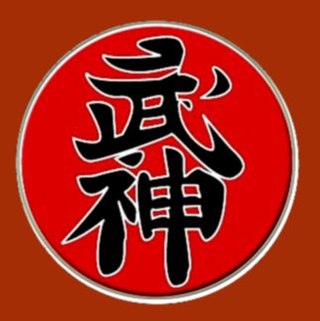
The Bujinkan is an international martial arts organization based in Japan and headed by Masaaki Hatsumi. The combat system taught by this organization comprises nine separate ryūha, or schools, which are collectively referred to as Bujinkan Budō Taijutsu. The Bujinkan is most commonly associated with ninjutsu. However, Masaaki Hatsumi uses the term Budo as he says the ryūha are descended from historical samurai schools that teach samurai martial tactics and ninjutsu schools that teach ninja tactics.
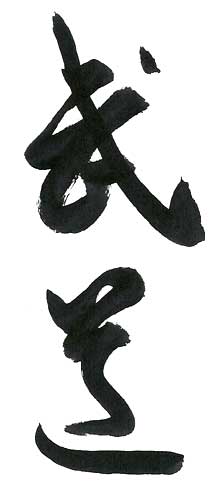
Budō is a Japanese term describing modern Japanese martial arts. Literally translated it means the "Martial Way", and may be thought of as the "Way of War" or the "Way of Martial Arts".

Gendai budō, or Shinbudō are both terms referring to modern Japanese martial arts, which were established after the Meiji Restoration (1866–1869). Kobudō or koryū are the opposite of these terms referring to ancient martial arts established before the Meiji Restoration.

Tenshin Shōden Katori Shintō-ryū (天真正伝香取神道流) is one of the oldest extant Japanese martial arts and an exemplar of bujutsu. It was founded by Iizasa Ienao, who lived near Katori Shrine at the time. The ryū is purported to have been founded in 1447, but some scholars state that it was about 1480.
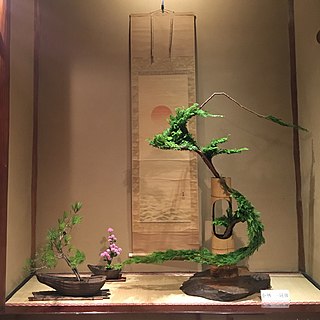
Ko-ryū is a Japanese term for any kind of Japanese school of traditional arts. The term literally translates as "oldschool" or "traditional school". It is sometimes also translated as "old style".

Gōjū-ryū (剛柔流), Japanese for "hard-soft style", is one of the main traditional Okinawan styles of karate, featuring a combination of hard and soft techniques. Both principles, hard and soft, come from the famous martial arts book used by Okinawan masters during the 19th and 20th centuries, the Bubishi. Gō, which means hard, refers to closed hand techniques or straight linear attacks; jū, which means soft, refers to open hand techniques and circular movements. Gōjū-ryū incorporates both circular and linear movements into its curriculum, combining hard striking attacks such as kicks and close hand punches with softer open hand circular techniques for attacking, blocking, and controlling the opponent, including joint locks, grappling, takedowns, and throws.
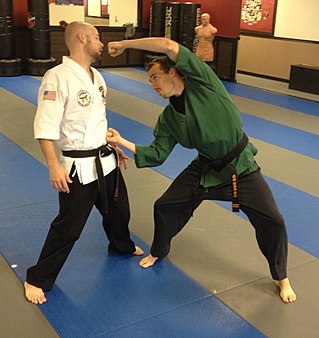
Kenpō is the name of several arts. The word kenpō is a Japanese translation of the Chinese word "quánfǎ" which literally just means "fist method" or "striking method". This term is often informally transliterated as "kempo", as a result of applying Traditional Hepburn romanization, but failing to use a macron to indicate the long vowel. The word Kenpō translates thus: "Ken" meaning 'Fist' and "Po" meaning 'Method' or 'Law' as in 'Law of gravity', a correct interpretation of the word Kenpō would be 'Fist Method', the same meaning as 'Quanfa'. However, it is often misinterpreted as 'the Law of the Fist'. The generic nature of the term combined with its widespread, cross-cultural adoption in the martial arts community has led to many divergent definitions.

Kobudō is a collective term for Japanese traditional techniques for the use of armour, blades, firearms, and techniques related to combat and horse riding. The kanji 古流武術 and 古武術 are other ways of writing it. The general umbrella term ko-ryū is also used to describe these ancient arts.
A jō is an approximately 1.27-metre (4.2 ft) wooden staff, used in some Japanese martial arts. The martial art of wielding the jō is called jōjutsu or jōdō. Also, aiki-jō is a set of techniques in aikido which uses the jō to illustrate aikido's principles with a weapon. The jō staff is shorter than the bō. Today, the jō is still used by some Japanese police forces.

Japanese martial arts refers to the variety of martial arts native to the country of Japan. At least three Japanese terms are used interchangeably with the English phrase Japanese martial arts.

Shōrinjiryū Kenkōkan Karate (少林寺流拳行館唐手) is a style of karate founded by Kōri Hisataka (1907–1988) shortly after World War II in Japan.

Shoji Nishio was a Japanese aikido teacher holding the rank of 8th dan shihan from the Aikikai. He was a direct student of Aikido founder Morihei Ueshiba, practiced along with Seigo Yamaguchi and Hiroshi Tada. He also achieved multiple high ranking honors in other martial arts, of which the most notable are Iaido, Judo, Karate.
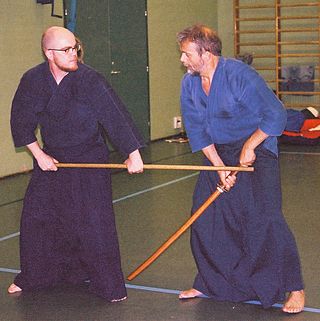
Shintō Musō-ryū, or Shindō Musō-ryū (神道夢想流), most commonly known by its practice of jōdō, is a traditional school (koryū) of the Japanese martial art of jōjutsu, or the art of wielding the short staff (jō). The technical purpose of the art is to learn how to defeat a swordsman in combat using the jō, with an emphasis on proper combative distance, timing and concentration. The system includes teachings of other weapon systems which are contained in Shintō Musō-ryū as auxiliary arts. The school is sometimes abbreviated as SMR.
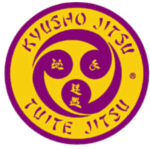
Ryu-te is an Okinawan martial art founded by the late Seiyu Oyata (1928–2012). The word Ryū-te is a shortened form of Ryūkyūte. Ryukyu is the original name of Okinawa prior to it becoming part of Japan. Before 1995, Oyata referred to his style as Ryukyu Kempo (琉球拳法), but eventually renamed it "Ryu-te" as Ryukyu Kempo was a reference to all styles originating in Okinawa rather than to any one particular style. Ryu-te emphasizes effective self-defense while deliberately minimizing the harm to the opponent. Its practitioners consider Ryu-te neither a sport nor a form of exercise, but rather a method of training the body and mind for the betterment of mankind.

Yoseikan budō (養正館武道) may be classified as a sōgō budō form, but is used here to indicate a martial art into which various martial ways have been integrated. It is probably most widely known for its descent from a pre-war style of aikido; however, it has important connections to judo, karate, western boxing, savate, and a traditional forms of Japanese combat known as gyokushin-ryū jujutsu and Tenshin Shōden Katori Shintō-ryū.

Hōten-ryū (法典流) is a Japanese martial art founded in 1600 CE. It is a school founded on the use of the sword; however it has several different kobuki in its curriculum. It is also notable for its hidden weapons or items that appear to hide among everyday things.
Dō is the go-on vocalization of the Japanese kanji道, corresponding to Mandarin Chinese (pinyin) dào, meaning "way", with connotations of "philosophy, doctrine".
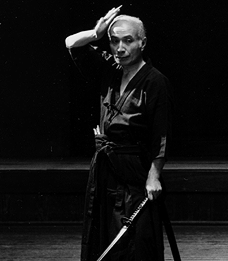
Saitō Satoshi was the 5th generation Sōke of Negishi-ryū, a classical Japanese warrior tradition and the nation's last surviving specialist school of Shurikenjutsu. From 1997 to 2014, Saitō served as the elected Chairman of the Nihon Kobudō Shinkōkai, Japan's oldest classical martial arts association. In addition, Saitō was the 6th generation head of Shirai-ryū shurikenjutsu and the 15th Sōke of Kuwana Han-den Yamamoto-ryū Iaijutsu. In 1992, Saitō was awarded the Imperial Order of the Sacred Treasure.















